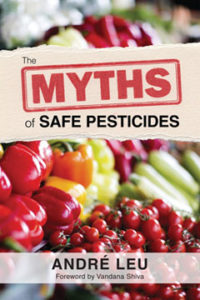 |
| Organic farming and gardening can feed the world, said André Leu: “For a fraction of the cost of developing a few GMOs, we could use that money for education and training, and we could take that 800 million [food insecure] people out of poverty within two to three years.” English photo. |
André Leu, president of the International Federation of Organic Agricultural Movements (IFOAM), the world umbrella body for the organic sector, gave a keynote speech at the 2014 Common Ground Country Fair about “The Myths of Safe Pesticides” – also the title of his recent book (see our review page). His talk is posted at https://www.youtube.com/watch?v=lBrxUFVbakE.
Leu has more than 40 years of experience in organic agriculture and agroecology, as well as degrees and 20-plus years of experience in communications and education. He and his wife, Julia, farm an agroecological organic tropical fruit orchard in Daintree, Queensland, Australia. He has published widely about organic agriculture, climate change, the environment and the health benefits of organic.
Leu began by saying that as an organic farmer, “I just adore what you’re doing here. And I’m really excited about seeing the next generation here. One of the things we can celebrate as organic farmers is that we’re growing farmers – youth, women – and whereas farmers are disappearing around the world, we know that we are getting over 200,000 new organic farmers every year around the world. We’re part of the revitalization and regeneration of agriculture.”
Tested and Safe?
Leu said he wrote “The Myths of Safe Pesticides” “because every time we have a campaign to get a pesticide banned, we’re told, ‘Where’s your data? Where’s your science that it’s dangerous?’” The book consolidates the science and outlines five large myths about pesticides.
One myth, said Leu, is that all pesticides are scientifically tested and are safe when used as directed. However, only one “active ingredient” in a pesticide product is scientifically tested, such as glyphosate in the herbicide Roundup. Surfactants and other added chemicals are not tested; nor is the actual formulation. In the United States, the EPA has approved 1,400 pesticide formulations; not one has been tested as a formulation for chronic diseases, such as cancer, damaging the nervous system or endocrine disruption.
 |
| Leu’s book discusses such myths as “all pesticides are scientifically tested and are safe when used as directed.” |
Some pesticide active ingredients are tested for the LD50 – the dose that kills 50 percent of test animals in two weeks. That will not let you know, said Leu, whether the active ingredient may cause cancer, birth defects, nervous system degeneration, diabetes or obesity.
Also, while multiple pesticides are usually used on crops, effects of multiple residues are not tested, or considered by regulators. The few studies that have been done show that multiple residues can be additive or synergistic. “Instead of 1 + 1 = 2,” said Leu, “1 + 1 can equal 5 or 10 or 1,000 in extra toxicity.”
Effects on Fetuses and Children
Nor are effects on fetuses and growing children tested – even though they do not have the same protective compounds as adults. “We know that amounts up to 1,000 – even in some cases 1 million – times lower will affect the developing fetus and the young, particularly their nervous systems. We now have very good data that even the most minute exposure of the fetus to organophosphates, neonicotinoids, carbamates, pyrethroids – all nerve poisons – while the nervous system is developing causes structural changes to the nervous system, particularly the brain.” Data link the epidemic in ADHD to damage to children’s nervous systems by these nerve poisons, said Leu, adding that autism spectrum disorders, bipolar disorder and schizophrenia may also be linked to even small amounts of these nerve poisons.
Outdated Methods and Endocrine Disruption
To test pesticides for hormone disruption, scientists can use MRI scans so that animals don’t have to be killed and so that effects can be seen in real time and at the parts per billion or trillion level. They can also test toxicity on cell lines.
Instead, some scientists, Leu said, still use a 400-year-old concept of toxicology: that the dose makes the poison. “They treat the animal, kill it, and look at it under a microscope for the ‘no observable effects level’ or ‘the null level.’ Then they say at that level it’s safe, and if we make [residue levels] 100 times or 1,000 times less, it’s safer.”
But with endocrine disruption, substances at the parts per billion or parts per trillion level can mimic hormones and become more toxic than at higher levels. “It’s called a non-monotonic dose,” said Leu. Hundreds of chemicals act this way.
How? Leu explained that our cells have hormone receptors with a certain shape, and when a hormone of a different shape is present, it does not fit with those receptors. But when some chemicals are present at very small levels, they can then fit with those receptors.
“The best analogy is a door with a lock and a key,” said Leu. “Only the key with a special shape will open the lock. If I try to stick a metal bar in the keyhole, it’s too big – it won’t open the door. But I can turn that metal into a fine, thin wire and make it into a lock pick. That’s what happens with these chemicals. In large amounts, they’re like the big metal bar; in very small amounts, they’re like the lock pick. They can open that hormone receptor and send a signal” – but it’s a false signal, because they’re not the actual hormone. “That’s called hormone disruption or endocrine disruption.”
 |
| Ted Quaday, MOFGA’s executive director, presented Leu with this year’s T-shirt after his speech. English photo. |
Many of these hormones mimic estrogen – and the age of puberty in girls is decreasing. Younger puberty is associated with breast cancer risk, and the rate of breast cancer is increasing worldwide, according to the International Agency for Research for Cancer.
For men, the prognosis is worse, said Leu. “If we reach our 80s, we will either die with or die of prostate cancer.
“We’re seeing around the world an incredible increase in the rise of cancers of the sexual tissues – breast, prostate, testicular, ovarian, uterine – because of endocrine disruption. We’re seeing declines in fertility, declines in sperm counts. We’re seeing damage to the nervous system.”
Hormone disruption may also contribute to childhood obesity. “Yes, they’re probably eating a lot of the food they shouldn’t be, but the normal insulin or blood sugar processes aren’t working normally. So when they eat food, instead of turning it into glucose to use for energy, their metabolism turns it straight into body fat.” Because children don’t get that glucose energy, they’re hungry and eat more. This spiral leads to type 2 diabetes, which is increasing worldwide.
Pesticides Break Down – to What?
Another myth is that modern pesticides break down rapidly. However, many are just as residual as DDT, dieldrin and others, said Leu; yet others break down relatively quickly compared with DDT but to more toxic and persistent chemicals than the original chemical. Organophosphates, for example, break down into oxons, which, on average, can be 100 to 300 times more toxic.
Regulatory agencies make data-free assumptions that these breakdown products (and cocktails of active ingredients, breakdown products and “inert” ingredients) are safe, even though they are rarely tested and the science that does exist shows they’re clearly unsafe, said Leu.
Blood tests show that most Americans carry multiple chemicals. The Environmental Working Group found up to 232 chemicals in placental cord blood.
“Our children are being born pre-polluted,” said Leu. “For me, that shows the complete failure of the regulatory system in protecting our most valuable asset, our next generation.”
 |
| Leu was excited to see the young crowd and all the organic foods at the Common Ground Country Fair, as well as the horticultural biodiversity displayed in the Exhibition Hall, co-coordinated by Amy LeBlanc (shown here). English photo. |
Because pesticide manufacturers and regulators will not do the proper science for a long time, Leu urged consumers to eat organic food – and to push for unequivocal proof that pesticides are safe before they can be used.
Q and A
Asked about genetically engineered (GE – or GMO, for genetically modified organisms) 2,4-D-resistant crops, Leu said these were developed because crops engineered to resist the herbicide Roundup led to weed resistance to Roundup. He said new GE crops will have stacked traits, with resistance to Roundup and to the herbicide 2,4-D. A major breakdown product of 2,4-D is dioxins – “one of the most toxic products on the planet,” damaging the nervous system, causing cancers and disrupting endocrine systems. “This whole thing of GE crops reducing chemical use is another fallacy that these companies are very good at putting out,” said Leu.
Regarding washing pesticides off produce, Leu said that systemic pesticides (those that are taken up by the plant or animal) such as Roundup and dimethoate (used to kill fruit fly larvae) are in the crop and cannot be washed off.
Leu related that when he started keeping poultry, books advised: “Don’t feed them your outer lettuce leaves because the pesticides will kill them.”
“I thought, ‘Oh, that’s all right, we’ll just put them on our children’s sandwiches instead.’ You cannot wash these poisons off. They’re systemic, or they’ve been applied with surfactants, which enable them to stick to the crop – even when you wash it.”
About the effect of Bt on people who ingest it, Leu noted that Bt (the bacterium Bacillus thuringiensis) makes compounds called lectins. The bacteria themselves are specific to specific pests when used in organic farming. One product will kill only caterpillars; another, only beetles. Also, organic growers use the live bacteria externally on plants; these bacteria generally die within 12 hours in the sun, so Bt residues aren’t present on organic produce sold to customers.
But GE crops have been engineered to contain the genes to express the toxic Bt lectin in every cell – including those that consumers ingest. Also, the process of putting these genes into plants makes the lectins more toxic than naturally occurring lectins, which can lead to allergies and to nervous system and digestive system disorders. Feeding trials with animals show inflammation of all their tissues. Pigs experience stillbirths, abortions and lower birth rates. These health problems are reversed when pigs are switched to non-GE feed.
Asked about pesticides approved for organic production, Leu said natural pyrethrins and spinosad are probably the two most toxic. “The difference between these and synthetic pesticides,” said Leu, “is that they are not residual. Natural pyrethrins and spinosad break down within 24 hours. That is why they’re allowed.
“After 40 years of being an organic grower, I don’t use pyrethrins anymore.” Leu said that emulsified vegetable oil, soap and water, or clay and water will kill insects just as well.
“The best way, and what most of us do, is design systems where pesticides are the tools of last resort, not of first resort.” Research in organic farming shows that where allowed biopesticides are used, the use is 90 percent lower than pesticide use in conventional agriculture. “And we only allow them because they are nontoxic or break down so rapidly that there is no residue on the produce that is sold. So on that level, you can be assured that organic food is the safest food you can eat.”
Asked how to get rid of long-term residual pesticides that accumulated on a piece of land, Leu said that biology – microbial life – breaks down pesticides. “So put lots of compost on your soil, grow green manures, just build up that organic matter. As you do, you’ll see that even things like DDT and dieldrin will disappear. That’s why we have a three-year conversion period in organic agriculture. It takes about that long to get rid of them.”
About the biggest myth – that only conventional agriculture can feed the world, and that without pesticides, we’ll all starve – Leu said the world now produces 2.5 times the amount of food we can consume, and more than half the food grown in the world is wasted.
“It’s a myth that we need to grow more food to feed the 800 million people who are undernourished. We can’t do it now, and if we double production, we still won’t be able to do it, because the problem is with the free market system. Pretend we get some great new GMO and double production in Kansas. (That won’t really happen.) That won’t go to a farmer who’s starving in Malawi, because he can’t afford it … There’s no profit to be made to send it to the people who are hungry, because they don’t have the money to buy it. It will go to feed chickens or factory hogs, because that’s what the market wants.
“The majority of the 800 million people who are hungry … are actually smallholder farmers in the developing world. We have very good data in our organization, which works in 120 countries, showing that we can work with these traditional farmers and more than double their production. We can take them from abject poverty to prosperity.
“One UN study reviewed 114 projects in Africa across 2 million hectares and 1.9 million organic farmers. When we taught these farmers good organic techniques on top of their traditional systems – how to compost, better weed and water management – on average we got 116 percent increase in yields.” Families that previously went to bed hungry at night could now build nice houses, send their children to school, afford medical bills. “It changes their lives, invigorates their communities. The children now are starting to come back into the communities and work the farms, because they can make a viable living.”
Leu also noted that the agribusiness chain produces only 30 percent of the world’s food; “70 percent is produced by most of us here – family farmers, and particularly in the developing world by people with very small areas of land – 5 acres or less, and they live on $400 or less per year. That’s 87 percent of the world’s farmers. In the developing world they produce 80 percent of the food in their countries. But globally we produce 70 percent. Because in the developing world we can get 100 percent increases in yield and greater, you can take 70 percent of the world’s food production and double it to 140 percent – that’s something GMOs can’t do. We do that. We feed the world.
“And we don’t need to spend hundreds of billions of dollars developing GMOs. We just need education and training. It’s simple. For a fraction of the cost of developing a few GMOs, we could use that money for education and training, and we could take that 800 million people out of poverty within two to three years.”
About governments backing down on GE labeling due to fear of lawsuits, Leu said GE corporations’ power is a real issue. “They’re being bullies to try to force things through. If people speak out, they’ll try to sue them. We know now they blackmail people as well to get them to change sides. There’s a whole range of evil tricks they do. But there’s an old saying: ‘If good people do nothing, evil prevails.’ I think in the end it’s us, the groundswell, we need to turn things bottom up, not top down. We need to have the power where it belongs – at our community level. We need to use that power in our purchasing decisions, in our messages to governments and corporations. It’s about us working together to defeat them, because we are the majority.”
About effects of pesticides, especially neonicotinoid insecticides, on pollinators, Leu said, “If we just got rid of neonics, we wouldn’t get rid of the problems. It’s a huge issue. All around the world we’re having bee colony collapse. We can look at neonics as one issue. We can look at other chemicals, pesticides, as endocrine disruptors affecting behavior of pollinators … Insects use hormones called pheromones to communicate. Because these chemicals disrupt hormones, they’re interfering with the whole ability of the insect world to communicate. Also, toxic load is affecting bees’ normal defenses or immune system. So the varroa mite, which has always been on bees, is now … killing whole colonies. The immune system can’t deal with it. It’s the same with frogs collapsing due to diseases they could previously deal with, because their immune system is damaged by this cocktail of chemicals. Scientists have a reductionist approach and say they can’t find one single cause. Of course you can’t find one single cause. It’s all the chemicals, a cocktail of chemicals. The way to change that is to change agriculture, to scale up organic agriculture so that we get rid of this cocktail of chemicals. We don’t need them.”
About spraying to control mosquitoes, Leu said, “Generally spraying mosquitoes has been shown to be a failure. One example used around the world to show how sprays should not be done is the spread of West Nile Virus across the United States. It started in one small area in New York state and spread from there. When you spray, you kill some, but others survive and you disperse them. So the spread of West Nile is largely due to the spray program. In most cases, spray programs make it worse.
“It’s like weed eradication programs,” said Leu. “They’re really weed enhancement programs. I’d like to know where one of these has actually eradicated a weed anywhere, yet every year they’re out spraying, and they’ll spray again next year.”
Most mosquitoes don’t spread diseases, said Leu. He suggested using lavender oil or citronella oil rather than toxic repellents on our bodies; using netting and screens; eliminating mosquitoes’ breeding sites; and, if spraying is necessary, using naturally occurring insecticides such as Bt israelensis, which affects only mosquitoes and black flies and is effective.
– Jean English
